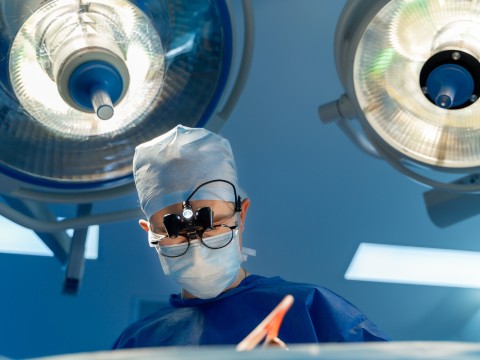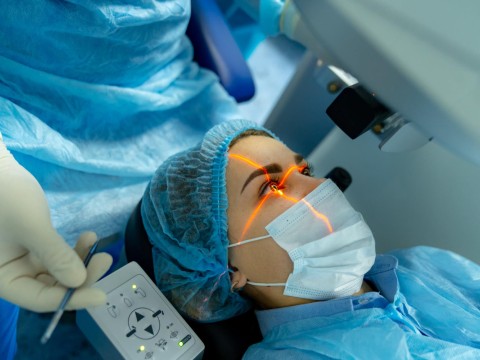No Touch Laser - Trans PRK
No Touch Lazer or Trans PRK- Transepithelial Photorefractive Keratectomy is the most advanced and non-invasive laser eye surgery, which corrects refractive errors like myopia, hyperopia, and astigmatism. This technique does not require cutting the flap on the cornea as done in conventional LASIK. It is a much safer option for patients with thin corneas and can avoid complications. This advanced technique reshapes the cornea without physical contact by using highly sophisticated laser technology.
The fact that this is painless to apply, recuperation takes a shorter period, and can be applied to less-than-perfect candidates than other laser eye surgical methods has increased the demand for this method. Trans PRK eye treatment has been quite an advantage for people who are involved in contact sports or dangerous jobs, which could traumatize their eyes. But how does the No Touch Lazer procedure go about it? What are the main advantages, and who can this treatment be performed on? We are going to investigate these and many other questions in this article.
What is No Touch Lazer?
No Touch Lazer or Trans PRK is a surface ablation procedure that doesn't touch the form of any type of corneal incision. During the procedure, an excimer laser reshapes the cornea without touching the eye for restoring vision. This treatment works effectively for patients with thin corneas, dry eyes, or those who cannot go through LASIK due to their lifestyle.
How Does No Touch Lazer Work?
The Trans PRK procedure is done in two steps. First, the laser gently removes the thin outer layer of the cornea, known as the epithelium. The laser then reshapes the underlying tissue of the cornea, making the improvement in how light reaches the inside of the eye. No blades and flaps are used in contrast to traditional LASIK, hence minimizing the risk and the time of recovery.
No Touch Lazer: Benefits
Non-invasive: No incisions or flaps are performed, which minimizes the risk of complications.
Faster recovery: Healing is faster, though with some initial discomforts, compared to traditional PRK methods. Less risk for thin corneas: Patients who have thin corneas or dry eyes, for which LASIK is contraindicated, can undergo No Touch Lazer.
Differences Between No Touch Lazer and LASIK
Apart from this, the basic difference between No Touch Lazer and LASIK is that in Trans PRK, there is not any flap created on the cornea. During the LASIK procedure, a flap is created on the cornea, and this flap might cause some complications when it does not heal as expected. No Touch Lazer does not carry this risk because it works directly on the surface of the cornea. Thus, it is safer for people who are into contact sports or are handling high-risk professions.
Possible Side Effects of Trans PRK
Even though No Touch Lazer is a safe surgery, it also has some side effects. Among the common ones are:
Temporary dry eyes: The patients can have a feeling of dryness for a couple of weeks after surgery.
Mild discomfort: During the healing process, slight irritation may occur or sensitivity to light.
Blurred vision: It may be blurry for a few days from the treatment but will improve while the cornea heals.
What is the Process of Recovery?
Compared to other laser eye surgeries, the recovery period for No Touch Lazer is relatively fast. Though most patients see clearly in a few days, full recovery from No Touch Lazer takes a few weeks. During this period, it is important not to have straining of the eyes and proper use of prescribed eye drops is very crucial to prevent dryness and infection of the eyes.
Who is the Good Candidate for No Touch Lazer?
No Touch Lazer suits those patients with thin cornea or for those leading active lifestyles where injuries to the eye are more prevalent. It's also great for people suffering from dry eyes or for those who would want a non-invasive method of treatment. However, it is highly critical to assess the suitability of your eyes by an ophthalmologist.
No Touch Lazer or Trans PRK is a safe, effective, and minimally invasive treatment for vision defects. Non-invasive, fast recovery, and treating thin corneas make this modality very attractive to most individuals. Whether one is seeking this for his or her correction of vision or searching out an alternative to LASIK, consultation with a qualified eye surgeon is the first step in determining if No Touch Lazer is correct for you.
- Health Insurance
-
Accommodation
- Online Healthy Life Assistant 9/5
- Post - Experience Follow Up 6 Month
-
Extra Privileges

- Health Insurance
-
Accommodation
- Online Healthy Life Assistant 24/7
- Post - Experience Follow Up 2 Year
- Pre-Treatment Doctor Consultation
-
Extra Privileges

 Private
Private
- Health Insurance
- Healthy Life Butler
- Post - Experience Follow Up 2 Year
- World-Famous Doctor Consultation
-
Extra Privileges
No suitable hotel found for the relevant dates!
* Price varies depending on extra and upgrade selections.
Contrary to what is known, Lasik Eye Surgery is a easy and painless treatment method when performed by skilled doctors. In this application, which lasts between 10 and 15 minutes on average, the time the laser is applied to the eye is not even 30 seconds. As a result of Lasik Surgery, there is no change in the anatomical structure of your eye. After the treatment, the person gets rid of the use of glasses or lenses and reaches a comfortable, comfortable and free life standard.
There are some patient-specific criteria for performing LASIK eye surgery: - The age determined for the operation according to the age of progression of the eye numbers is 18 years. - In order for the patient to be included in the scope of surgery, the eye number must be in appropriate values. These values are up to -4 in hyperopia, up to -10 in myopia, and up to -6 in astigmatism. • The number of contact lenses or glasses must not have changed in the last 1 year. There can be other criterias that your doctor will examine to decide on suitability.
Before LASIK eye surgery is performed, patients undergo a comprehensive eye consultation.During this consultation, medical and surgical intervention history is learned and the patient's suitability for the operation is determined.
After the operation, eye watering, burning sensation, blurred vision or itching may occur. However, this situation is temporary and the improvement in vision is completed quickly. One or two days after the operation, your controls are carried out at the follow-up appointment scheduled for you by your ophthalmologist. Recovery duration is 8-10 days.
Diabetic patients are not recommended to be laser due to wound healing and immune system disorders. In diabetic retinal hemorrhages, Argon laser, another laser type, is treated.
Pain, stinging and watering may occur up to 6 hours after laser operations such as Intralase-LASIK and LASIK, which are performed by creating a flap (flap) in the cornea. But after that generally there won’t be a pain.
In most cases, the vision improvement provided by LASIK surgery is permanent. However, in a limited number of cases, myopia, hyperopia, and/or astigmatism may recur over time, causing blurred vision due to changes that may occur in the lens inside the eye, usually with or without LASIK surgery. If such regression occurs and becomes bothersome, a follow-up procedure called LASIK enhancement can usually be performed to restore clear vision.




.jpg)